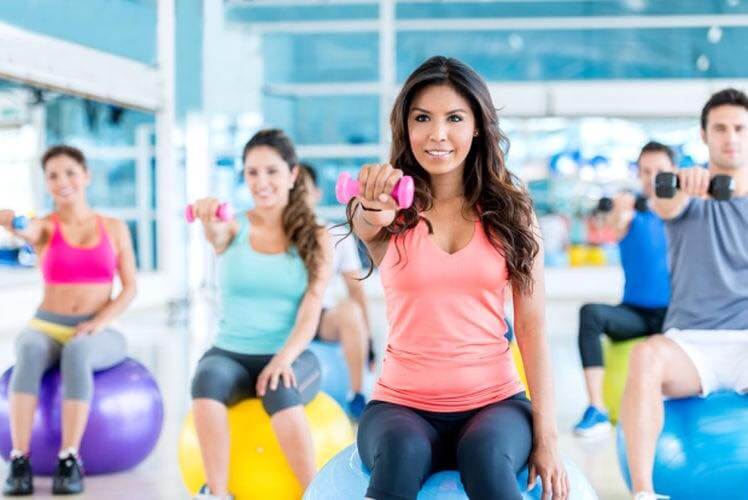
Balance is a crucial survival skill. Stats show that about 20% of women who fracture a hip become permanently disabled, and another 20% die within a year. Health problems linked to hip fractures result in more women deaths each year than breast cancer does. Improving balancing not only prolongs life span but also has several other immediate health benefits. They are fewer injuries, better mobility and greater capacity to carry out intense exercises.
Here are a few ways to strengthen the core and lower-body muscles.
Standing on one leg
You can hold this pose for 30 sec on each side. It can be done while carrying out mundane activities that involve standing for long periods, such as cooking or washing the dishes.
Walk heel to toe
Walk in a straight line heel to toe. Take 20 steps forward and then walk backward. This technique is also used by drunk drivers to improve balance and avoid accidents.
Do squats
Sturdy legs prevent stumble from turning into a fall. Squat technique – stand feet hip-width apart, bend knees and hips, lower yourself slowly as though you are sitting on a chair placed behind you. Arms straight, abs tight, back straight.
Take up ballet
Ballet dancers move with precision and grace when compared to those who do not have any gymnastics training. Ballet uses many muscle groups so the dance strengthens your nervous system’s ability to coordinate muscle groups so you keep your balance.
Get a good night’s rest
Sleep deprivation slows reaction time. A study at California Pacific Medical Center shows that it is also directly related to falls. Researchers studied 3,000 women and found that those who slept more than 5 hours each night were more likely to fall than those who slept longer. A good night’s sleep is a deep sleep for 8 hours or more.
Exercise is crucial to improve balance for active agers. Independent people who fall under the healthy group of people over 50 years of age capable of standing and walking can do these exercises. These exercises will improve physical and mental activities of daily life. They emphasize standing balance for lower and upper body, and core. You can do these exercises in less than twenty minutes or even stretch it to a comprehensive workout by increasing the number of repetitions. You can increase the number of times you carry out these movements as you become fit and develop more strength with extensive workouts.
Side Balance Reach
Stand on the right leg and lean the whole body towards the right. Move the left hip slightly above so it loses contact with the floor and move the right shoulder toward the sky. Once in this posture, the body makes half of an ‘X’ shape. Hold for 30 seconds. Touch down with the left toes to stand on both the legs. Then repeat it on the opposite side. Continue this exercise for up to two minutes
Stand and Twist
Stand on the left leg and raise the right knee up until the upper thigh is parallel to the floor. If you are finding it difficult to hold this posture, just raise the heel of the right foot instead of trying to balance it as parallel.
To twist, bring the hands together in the position of prayer and point fingers forward, away from the body. Twist to the right and left making a large infinity design with your hands. Try to twist as far as possible but do not go beyond when feeling a strong pull or any discomfort apart from the twist of muscles. Repeat on the opposite side after two minutes. This will work out your eyes, head, core, and legs.
Raised Hinge
Stand straight with feet placed at hip-width distance. Raise the left heel to create a stability challenge by reducing the contact points with the floor. Place hands at the hips and slowly fold forward over the hands and flex at the hips. Make sure you do not flex at the spine. Keep the spine as extended as possible. Flex the knees if the hamstrings are tight. Hinge and “bow” down and up as if a bird is drinking water. Perform the posture movement slowly for one minute and then repeat with the other heel raised. Concentrate on keeping the spine long and strong.
Squat and Twist
Keep feet hip-width distance. Lower to a sitting position. Try to keep the toes within view to minimize the projection of the knees forward. For a regression, lean against a wall while lowering. Make sure to start with feet far enough away from the wall so that the knees stay behind the toes in a lowered position. Bring the hands behind the head so the elbows are flexed, pointing to the sides in the frontal plane.
Try to keep the spine as extended as possible while twisting on the left and right side. Move slowly from the right to the left side. Repeat five times on each side. Return the starting position to rest by shaking the legs and repeat for one minute.
Active Lat Stretch
Sit in a squat position and use the wall for support. Slide arms and thumbs up and down the wall slowly for one minute. You will feel the stretch from the hips all the way to your shoulders. Try to reach the fingers closer to the sky. The up-and-down movement in this exercise should not be performed faster than 10 seconds. Count the numbers as you do the exercise to make sure you are not faster than required. Quick movements of this exercise can result in a muscle tear.
Standing Twisting Lunge
Stand with feet together and step forward with the left foot. Try to bring the left upper thigh parallel to the floor. Make sure you are stable in this position before moving to the next part of this exercise. You can also place a chair at the side for support if required.
Place right hand behind your head and flex your elbow pointing to the side. Twist the entire core to the left and try to keep the spine as extended as possible. Do extend your spine and but do not go beyond if you feel uncomfortable. Also, do not strain or stress on this exercise if you have a weak spine or calcium deficiency for prolong period of time.
The purpose of this exercise is to strengthen your core and muscles which in turn will improve your balance while walking. But weak bones or any existing health condition that causes brittle bones should not be risked with this exercise.
After holding one lunge position for five seconds, untwist and return to the starting position with the feet together. Repeat on the same side as many times as possible with control for one minute and repeat on the opposite side with the same guidelines.
Standing “X” Skating Balance Reach in the Sagittal Plane
Stand with feet shoulder-distance apart. Place a chair in front for support, if required. Flex your left shoulder forward and up. Simultaneously stretch the right hip, making a contralateral half of the letter X. Gently lower to the starting position and repeat on the opposite side. Continue this stretch for up to two minutes, moving slowly and deliberately as if moving through peanut butter. Try to keep the spine as neutral as possible when bending forward from the supporting ankle. Return to the standing position. Count up to ten seconds while lifting and lowering on each side. It would feel like ice-skating in slow motion.
Plank position with lifted hand
The name of the exercise might sound scary to those who are familiar with a plank. To do this exercise, lower your body to hands-and-knees position and then walk the hands out to a plank position. You can do this either on toes or knees. Count numbers while performing this exercise.
This exercise also helps as a ‘talk test’ to ensure proper breathing while maintaining an isometric position of stability. Try to raise one palm and keep the fingers on the floor. Once you gain stability with this exercise, you can increase the level of difficulty. Raise one hand completely off of the floor for half a second. Regain balance on both hands in the plank position and then raise the other hand. Repeat this balance game for appropriate up to one minute.
Performing these stabilizing moves can help active agers achieve a better sense of balance, strength and overall self-efficacy. All the suggested exercises are in a variety of planes and positions. It will train stability and mobility to maximize activities of daily life. Many people have a misconception that as we age, standing movements and a certain type of exercises have to be avoided. But research has been changing this belief as they emphasize a functional approach to an overall enhancement of daily life activities to promote self-efficacy.
The only time exercises have to be avoided is when restrictions are imposed due to medical condition. If there is a risk of brittle bones or any disease that results in causing weak bones, the exercises that involve extensive twisting and turning have to be avoided. They can do more harm than good.
The suggested exercises are for healthy adults who are beneficial for active agers and not physically frail. Research states that movement patterns for active agers should vary in every program among cardiovascular, strength and endurance, and flexibility and balance.
Cardiovascular training
It emphasizes specific, multi-planar patterns that provide task-dependent moves with a purpose. It could be marching in a spot, forward-backward movement, side-to-side movement, and rotational movement. Exercises that promote visual acuity, visual dependence on balance and eye training are beneficial.
Exercise: walk with hands at the hips, as though your hands are in your front pockets. Walk in line with space between feet, next with no space between feet. Increase the speed as appropriate. Repeat or walk backward.
Strength and endurance
Resistance training is given for muscles of the core and legs as these are most essential to balance the body. Floor exercises are to work the leg and core system
Exercise: Hold a soft ball and gradually transfer the ball to the moving hand. Balance a 1-pound bag of lentils on your head to encourage neck balance. Follow the ball and your moving hand with the neck and eyes to train the vestibular system.
Balance and flexibility
Training improves self-efficacy and aids in boosts the overall functionality of movement. Balance and connective tissue range of motions are mutually dependent to prevent injury. This helps while getting out of a chair or reaching out to pick a child/grandchild. So training in these concepts proves functional.
Exercise: draw your toes towards your shins. Point your toes away from the shins. For each repetition allow one ankle to dorsiflex and one foot to plantarflex, alternating for each routine. To increase the level of difficulty in the exercise, try single-leg bridging, with or without the medicine ball between the knees. This will strengthen the leg, hip and core muscles.
There are several exercises that help with each of these three programs. Choose the exercises that suit you. They should be comfortable to start with. Increase the repetitions and make it three sets of fifteen once the training regimen is regular. You can also increase the number of exercises or raise the level of difficulty. This will challenge your body and increase the balance, flexibility, and ability to move better.
Following a training regimen that incorporates attention to, and balance among cardiovascular, strength and flexibility movement patterns will help create self-efficacy allowing you to lead a happier, healthier and fitter life.
